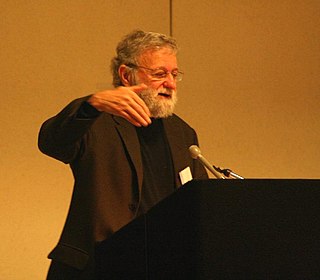
Donald Arthur Norman is an American researcher, professor, and author. Norman is the director of The Design Lab at University of California, San Diego. He is best known for his books on design, especially The Design of Everyday Things. He is widely regarded for his expertise in the fields of design, usability engineering, and cognitive science, and has shaped the development of the field of cognitive systems engineering. He is a co-founder of the Nielsen Norman Group, along with Jakob Nielsen. He is also an IDEO fellow and a member of the Board of Trustees of IIT Institute of Design in Chicago. He also holds the title of Professor Emeritus of Cognitive Science at the University of California, San Diego. Norman is an active Distinguished Visiting Professor at the Korea Advanced Institute of Science and Technology (KAIST), where he spends two months a year teaching.
In psychoanalysis, a Freudian slip, also called parapraxis, is an error in speech, memory, or physical action that occurs due to the interference of an unconscious subdued wish or internal train of thought. Classical examples involve slips of the tongue, but psychoanalytic theory also embraces misreadings, mishearings, mistypings, temporary forgettings, and the mislaying and losing of objects.

Usability can be described as the capacity of a system to provide a condition for its users to perform the tasks safely, effectively, and efficiently while enjoying the experience. In software engineering, usability is the degree to which a software can be used by specified consumers to achieve quantified objectives with effectiveness, efficiency, and satisfaction in a quantified context of use.
In philosophy, an action is an event that an agent performs for a purpose, that is guided by the person's intention. The first question in the philosophy of action is to determine how actions differ from other forms of behavior, like involuntary reflexes. According to Ludwig Wittgenstein, it involves discovering "[w]hat is left over if I subtract the fact that my arm goes up from the fact that I raise my arm". There is broad agreement that the answer to this question has to do with the agent's intentions. So driving a car is an action since the agent intends to do so, but sneezing is a mere behavior since it happens independent of the agent's intention. The dominant theory of the relation between the intention and the behavior is causalism: driving the car is an action because it is caused by the agent's intention to do so. On this view, actions are distinguished from other events by their causal history. Causalist theories include Donald Davidson's account, which defines actions as bodily movements caused by intentions in the right way, and volitionalist theories, according to which volitions form a core aspect of actions. Non-causalist theories, on the other hand, often see intentions not as the action's cause but as a constituent of it.
In philosophy of mind and cognitive science, folk psychology, or commonsense psychology, is a human capacity to explain and predict the behavior and mental state of other people. Processes and items encountered in daily life such as pain, pleasure, excitement, and anxiety use common linguistic terms as opposed to technical or scientific jargon.
User-centered design (UCD) or user-driven development (UDD) is a framework of process in which usability goals, user characteristics, environment, tasks and workflow of a product, service or process are given extensive attention at each stage of the design process. These tests are conducted with/without actual users during each stage of the process from requirements, pre-production models and post production, completing a circle of proof back to and ensuring that "development proceeds with the user as the center of focus." Such testing is necessary as it is often very difficult for the designers of a product to understand intuitively the first-time users of their design experiences, and what each user's learning curve may look like. User-centered design is based on the understanding of a user, their demands, priorities and experiences and when used, is known to lead to an increased product usefulness and usability as it delivers satisfaction to the user.

In psychology, affordance is what the environment offers the individual. In design, affordance has a narrower meaning, it refers to possible actions that an actor can readily perceive.

Visual communication is the use of visual elements to convey ideas and information which include signs, typography, drawing, graphic design, illustration, industrial design, advertising, animation, and electronic resources. Humans have used visual communication since prehistoric times. Within modern culture, there are several types of characteristics when it comes to visual elements, they consist of objects, models, graphs, diagrams, maps, and photographs. Outside the different types of characteristics and elements, there are seven components of visual communication: color, shape, tones, texture, figure-ground, balance, and hierarchy.
In human computer interaction, the gulf of execution is the gap between a user's goal for action and the means to execute that goal. Usability has as one of its primary goals to reduce this gap by removing roadblocks and steps that cause extra thinking and actions that distract the user's attention from the task intended, thereby preventing the flow of his or her work, and decreasing the chance of successful completion of the task. Similarly, there is a gulf of evaluation that applies to the gap between an external stimulus and the time a person understands what it means. Both phrases are first mentioned in Donald Norman's 1986 book User Centered System Design: New Perspectives on Human-computer Interaction.
Product design as a verb is to create a new product to be sold by a business to its customers. A very broad coefficient and effective generation and development of ideas through a process that leads to new products. Thus, it is a major aspect of new product development.
The human action cycle is a psychological model which describes the steps humans take when they interact with computer systems. The model was proposed by Donald A. Norman, a scholar in the discipline of human–computer interaction. The model can be used to help evaluate the efficiency of a user interface (UI). Understanding the cycle requires an understanding of the user interface design principles of affordance, feedback, visibility and tolerance.
An implementation intention is a self-regulatory strategy in the form of if-then-plans that can lead to better goal attainment, as well as create useful habits and modify problematic behaviors. It is subordinate to goal intentions as it specifies the when, where and how portions of goal-directed behavior.

Dramaturgy is a sociological perspective commonly used in micro-sociological accounts of social interaction in everyday life.
Prospective memory is a form of memory that involves remembering to perform a planned action or recall a planned intention at some future point in time. Prospective memory tasks are common in daily life and range from the relatively simple to extreme life-or-death situations. Examples of simple tasks include remembering to put the toothpaste cap back on, remembering to reply to an email, or remembering to return a rented movie. Examples of highly important situations include a patient remembering to take medication or a pilot remembering to perform specific safety procedures during a flight.
In computer science, the gulf of evaluation is the degree to which the system or artifact provides representations that can be directly perceived and interpreted in terms of the expectations and intentions of the user. Or put differently, the gulf of evaluation is the difficulty of assessing the state of the system and how well the artifact supports the discovery and interpretation of that state. According to Donald Norman's The Design of Everyday Things "The gulf is small when the system provides information about its state in a form that is easy to get, is easy to interpret, and matches the way the person thinks of the system".
Behavioural change theories are attempts to explain why human behaviours change. These theories cite environmental, personal, and behavioural characteristics as the major factors in behavioural determination. In recent years, there has been increased interest in the application of these theories in the areas of health, education, criminology, energy and international development with the hope that understanding behavioural change will improve the services offered in these areas. Some scholars have recently introduced a distinction between models of behavior and theories of change. Whereas models of behavior are more diagnostic and geared towards understanding the psychological factors that explain or predict a specific behavior, theories of change are more process-oriented and generally aimed at changing a given behavior. Thus, from this perspective, understanding and changing behavior are two separate but complementary lines of scientific investigation.

The Design of Everyday Things is a best-selling book by cognitive scientist and usability engineer Donald Norman about how design serves as the communication between object and user, and how to optimize that conduit of communication in order to make the experience of using the object pleasurable. One of the main premises of the book is that although people are often keen to blame themselves when objects appear to malfunction, it is not the fault of the user but rather the lack of intuitive guidance that should be present in the design.
The term natural mapping comes from proper and natural arrangements for the relations between controls and their movements to the outcome from such action into the world. The real function of natural mappings is to reduce the need for any information from a user’s memory to perform a task. This term is widely used in the areas of human-computer interaction (HCI) and interactive design. Leveraging the concept of mapping helps bridge the gulf of evaluation and the gulf of execution, which refer to the gap between the user's understanding of the system and the actual state of the system and the gap between the user's goal and how to achieve that goal with the interface, respectively. By mapping controls to mirror the real world, the user will find it easier to create a mental model of the control and use the control to achieve their desired intention.

The health action process approach (HAPA) is a psychological theory of health behavior change, developed by Ralf Schwarzer, Professor of Psychology at the Freie University Berlin of Berlin, Germany and SWPS University of Social Sciences and Humanities, Wroclaw, Poland, first published in 1992.
An intention is a mental state in which the agent commits themselves to a course of action. Having the plan to visit the zoo tomorrow is an example of an intention. The action plan is the content of the intention while the commitment is the attitude towards this content. Other mental states can have action plans as their content, as when one admires a plan, but differ from intentions since they do not involve a practical commitment to realizing this plan. Successful intentions bring about the intended course of action while unsuccessful intentions fail to do so. Intentions, like many other mental states, have intentionality: they represent possible states of affairs.






